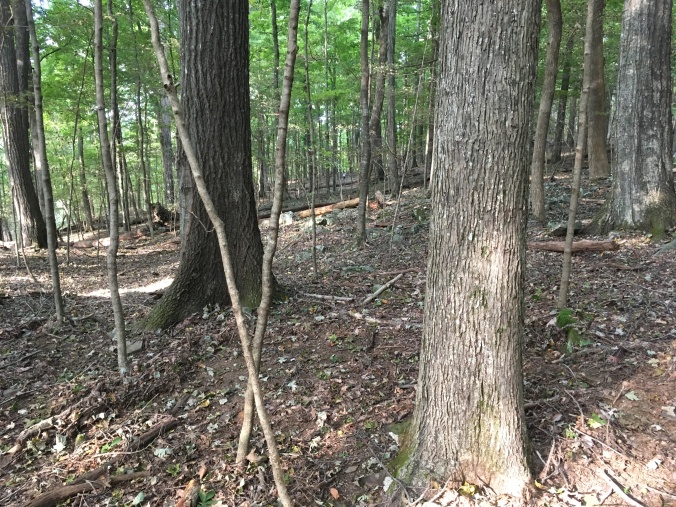Rich, cove forests are losing tree species faster than sandy, upland forest, according to long-term research in Sewanee, Tennessee led by Jon Evans (University of the South), Callie Oldfield (University of Georgia), and Leighton Reid (Virginia Tech).
The southern Cumberland Plateau in Sewanee, Tennessee is a ribbon of stacked limestone and sandstone rising above the valley by some 275 m, about four-fifths the height of the Eiffel Tower. From above, the plateau’s forests stand out dark green against the surrounding farmlands and give the impression of a large, homogeneous block of habitat.
The reality is somewhat different. The forests of the southern Cumberland Plateau are botanically distinct, and they are changing differentially over time.

The southern Cumberland Plateau near the borders of Tennessee, Alabama, and Georgia. Imagery © Google Earth 2019.
The plateau’s sandstone cap is dry and craggy. Blueberries thrive in acidic soil under a canopy of oaks and hickories. Where the soil is especially shallow, the forest opens up onto exposed outcrops with fence lizards and prickly pear cacti. Just a stone’s throw away, the cove forests are a world apart. Wet and calcareous, the plateau’s deep, dark coves are famous for limestone caves and ephemeral wildflowers. Even though they are close neighbors, the two dominant forest communities of this region share less than 25% of their plant species.

Upland forest on the top of the Cumberland Plateau, underlain by the sandstone. Photo by Jon Evans.
As part of a long-term forest change study, in 2014 we surveyed tree communities in upland and cove forests that had been previously surveyed in 1995 and 2005. Our results, published in the Natural Areas Journal, showed that upland forests maintained the same suite of tree species in roughly the same numbers, but cove forests became considerably less diverse. For example, we detected nine fewer tree species in the plots in 2014 compared to 1995. Understory trees were hardest hit – less than 1/3 of the species that were present in 1995 were still represented in the understory in 2014.

Cove forest in Thumping Dick Hollow, underlain by limestone. Photo by Jon Evans.
Being neighbors, upland and cove forests have been subjected to similar disturbances over the past few decades. For example, both forests have comparable exposure to wind storms, pathogens, and herbivores – particularly deer. White-tailed deer have become overpopulated due to the loss of their natural predators, and few tree seedlings escape their browsing. We have seen PVC plot markers chewed to the ground by ravenous deer. Our observations suggest that cove forest tree species are less resistant to these disturbances than their upland counterparts.
We speculate that some trees on the sandy uplands might be pre-adapted to the new deer browsing regime. Several upland tree species are clonal. For example, sassafras, sourwood, and chestnut oak trees can share resources with smaller seedlings that sprout from their bases or roots. The parental subsidy might help these species maintain their populations in the droughty, acidic upland soils of the Cumberland Plateau. It could also help seedlings keep growing after they have been munched by a deer.

Sassafras (Sassafras albidum) is a clonal tree species common in upland forests on the Cumberland Plateau. Photo by Callie Oldfield.
Clonal species are less common in the cove forest. There the dominant trees like sugar maple and tulip poplar typically reproduce via seeds. Paw paw is one of the few clonal species that grows in the cove forest, and it is also one of the few species that increased in abundance there from 1995-2014.

Leighton Reid (left) and Callie Oldfield (right) survey tree communities on the southern Cumberland Plateau in 2005 and 2014, respectively. Photos by Jon Evans.
The southern Cumberland Plateau is regarded by some conservation groups as a resilient southeastern landscape, and indeed its variable topography and large extents of natural habitat may help many species resist or respond to new environmental challenges. However, our research highlights that the two dominant tree communities of the southern Cumberland Plateau respond to disturbances differently and may have a limited capacity to buffer one another from ongoing change.
For more information, see our new paper in Natural Areas Journal. To request a pdf, email jon.evans@sewanee.edu.